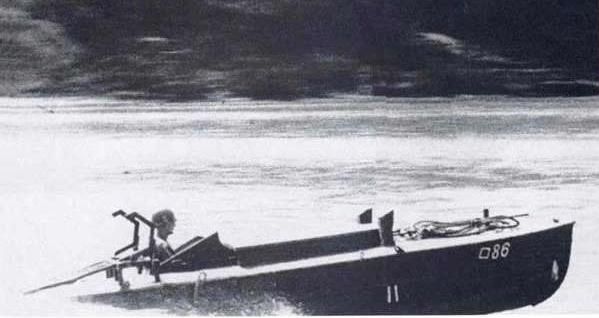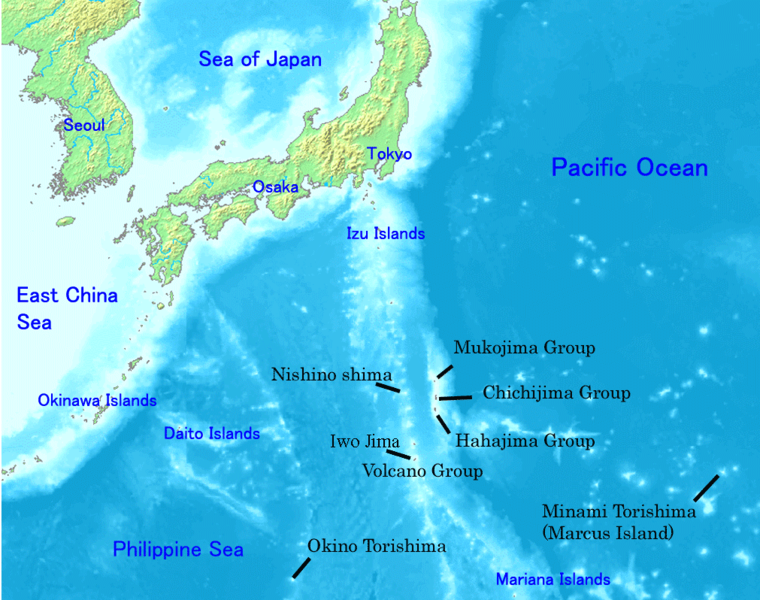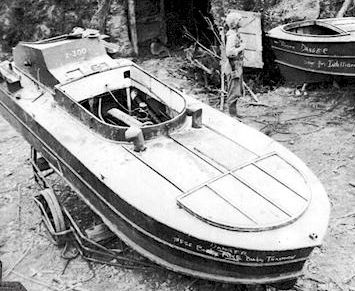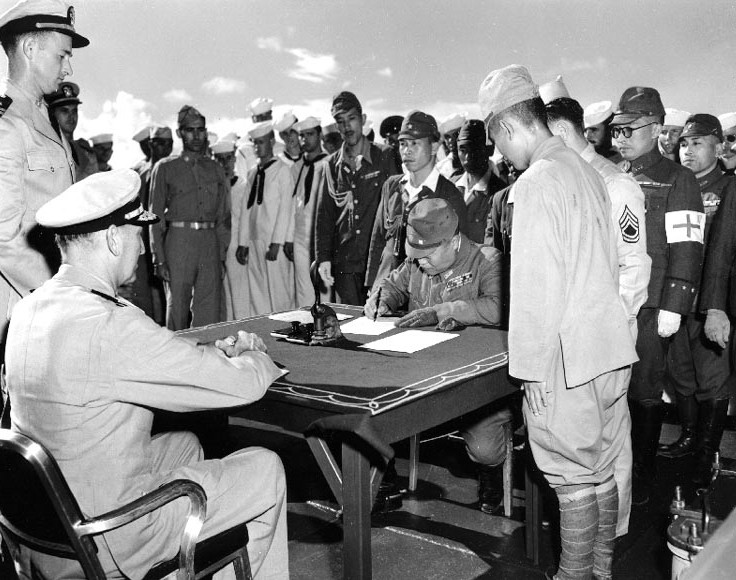SHINYO!
 (Captured EMB under test by an American
soldier)
(Captured EMB under test by an American
soldier)
Explosive Motorboats based in the
Ogasawara (Bonin)
Islands
1944-1945
© 2010 Bob Hackett and Sander Kingsepp
 Ogasawara (Bonin) Islands in the Pacific
1853:
Ogasawara (Bonin) Islands in the Pacific
1853:
The Ogasawara Islands lie about 1000 km S of Tokyo and about 1400 km E of Okinawa. Commodore Matthew C. Perry's side-wheel steamer USS SUSQUEHANNA (F) and sloop-of-war USS SARATOGA visit the islands as part of Perry’s tour to open Japanese ports to trade. Perry claims the islands for the United States. Later, the claim is disavowed by the American Government. [1]
1861:
The Japanese Government sends KANRIN MARU to explore the island group. Ogasawara Gunto is officially adopted as the name for the complex of islands consisting of the Chichijima, Mukojima and Hahajima island groups.
1875:
Japan sends a warship to Ogasawara Gunto and claims them for the Japanese Empire.
1944-1945:
Japan. A total of 6,197 Shinyo Explosive Motorboats (EMB) are manufactured for the Imperial Japanese Navy and 3,000 somewhat similar "Maru-ni" EMBs are built for the Imperial Japanese Army. The majority of EMBs are stored along the shores of coastal Japan for defense against the expected invasion of the Home Islands. Others are sent south to Japanese and Japanese-held islands.
 (Type 1 Shinyo)
(Type 1 Shinyo)
15 February 1944:
Rear Admiral Mori Kunizo (40)(former CO of AO SATA) is appointed CO of the Chichijima Area Base Unit. [2]
July 1944:
Yokosuka. The 1st Shinyo Squadron and the Chichijima Special Base Force are formed at the Naval Torpedo School. The 180 men come from each prefecture, from northern Sakhalin to southern Okinawa.
September 1944:
The 1st, 2nd and 5th Shinyo Squadrons are sent to Chichijima and the 3rd and 4th Shinyo Squadrons to Hahajima. Others arrive until the end of 1944.
27 September 1944:
At 1300, SEIAN and KISARAGI MARUs depart Yokosuka for Chichijima in convoy No. 3927 escorted by subchaser CH-42 and minelayer AJIRO. SEIAN MARU carries men of the Special Base Force and KISARAGI MARU carries men and boats of the 1st Shinyo Squadron.
1 October 1944:
NW of the Ogasawara Islands. At 0903, LtCdr William W. Walker's USS SNAPPER (SS-185) torpedoes and sinks SEIAN MARU at 28-20N 139-25E. Ten men are KIA. At 0914, SNAPPER also torpedoes and sinks AJIRO. CH-42 drops 24 depth charges, but SNAPPER suffers no damage.
2 October 1944:
CH-42 and KISARAGI MARU are attacked by nine B-24 bombers, but suffer no damage. That morning, KISARAGI MARU arrives safely at Futami port, Chichijima, followed later by CH-42. The men begin unloading the boats and equipment when the sky is lit up by a flare, followed by an attack by a Grumman F-6F "Hellcat" fighter.
3 October 1944:
Men of the 1st Shinyo Squadron begin constructing sheds and excavating tunnels for their boats in the rocky mountain side of Chichijima.
1944:
American planners consider Chichijima, located about 140 nms NE of Iwo Jima, as a potential target for an amphibious landing, but it is dropped in favor of Iwo because Chichijima's terrain would not permit rapid construction of airfields. Photo-reconnaissance also shows Chichijima to be more heavily fortified than Iwo.
December 1944-March 1945:
The 1st Shinyo Squadron undergoes night combat mission training in cold water.
5 January 1945:
Rear Admiral Allan E. Smith's Task Group 94.9 of USS CHESTER (CA-27), PENSACOLA (CA-24) and SALT LAKE CITY (CA-25) and destroyers USS CUMMINGS (DD-365), DAVID W. TAYLOR (DD-551), DUNLAP (DD-384), ELLET (DD-398), FANNING (DD-386) and ROE (DD-418), together with USAAF B-24s escorted by P-38s, attack Chichi Jima, Haha Jima, and Iwo Jima. Approaching Chichijima, destroyers DUNLAP, FANNING and CUMMINGS sink landing ship T.107 at 26-27N, 141-11E, but DAVID W. TAYLOR is damaged by a mine and FANNING by gunfire off Chichijima.
19 February 1945 - "Operation DETACHMENT" - Invasion of Iwo Jima.
Preceded by intense naval and air bombardment, Marine LtGen Holland M. Smith's 4th and 5th Marine Divisions assault Iwo. The operation is under the overall command of Admiral Raymond A. Spruance, CinC, Fifth Fleet; Vice Admiral (later Admiral) Richmond K. Turner is the Joint Expeditionary Force CO.
16 March 1945:
Iwo Jima is declared secured. After Iwo falls, Chichijima suffers daily air raids. Japanese radar on Chichijima's highest mountain point cannot detect low flying Grumman F-6F "Hellcat" fighters that strafe the island's shipping and Shinyo Squadrons' facilities.
1 May 1945:
Rear Admiral Mori is promoted Vice Admiral.
27 July 1945:
Chichijima. By this date, the 1st, 2nd and 5th Shinyo Squadrons have about 150 Shinyo EMBs and the island's garrison numbers about 3,500 men.
15 August 1945 - Cessation of Hostilities:
The war ends before the 1st Shinyo Squadron makes a single sortie. Chichijima is never captured.
3 September 1945:
Aboard USS DUNLAP (DD-384) off Chichi Jima. LtGen Tachibana Yoshio, senior Japanese commander in the Ogasawaras, surrenders the islands to Commodore John H. Magruder, Jr, USN. Chichijima and Hahajima's garrisons comprise 20,656 Army and Navy personnel and 2,285 civilian laborers. [3]
 (LtGen Tachibana signs the instrument of surrender aboard USS DUNLAP )
(LtGen Tachibana signs the instrument of surrender aboard USS DUNLAP )
October 1945:
A detachment of Marines is sent to Chichijima to help repatriate former Japanese servicemen. They are the first American troops to set foot in the Bonins since Commodore Perry's expedition in 1853.
Authors’ Notes:
[1] Although the evidence is dubious, the islands may have been discovered in 1593 by Ogasawara Sadayori in the service of the warlords Toyotomi and Tokugawa. In 1675, the Edo Government sent an exploration ship to investigate the islands. The expedition named the islands Bunin ("Bonin") Shima (uninhabited islands). About 1825, Captain Frederick W. Beechey’s HMS BLOSSOM claimed the islands for Britain. He renamed them the Archbishop Islands.
[2] Vice Admiral Mori was implicated in the murder of prisoners of war at Kendari, Celebes and cannibalism of captured airmen at Rabaul, New Britain and Chichijima. In 1949, Mori was executed by the Dutch for atrocities committed in the Netherlands East Indies.
[3] Tachibana also surrendered his kyu-gunto samurai sword, now on display at the U.S. Marine Corps Museum at Quantico, Virgina. He was convicted of a series of gruesome war crimes perpetuated on captured American aviators in the Ogasawaras. He was hanged at Guam.
Thanks go to John Whitman for info about the 1st Shinyo Squadron provided by one of its former members.
-Bob Hackett and Sander Kingsepp
Back to Explosive
Motorboats Page








